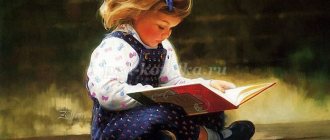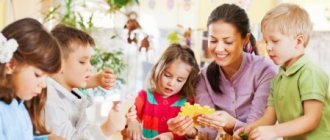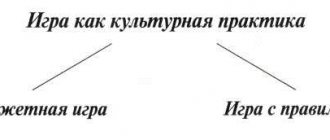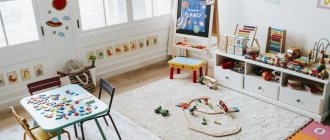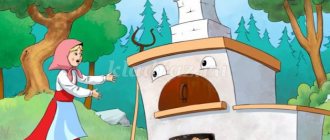Summary of the joint activity “The House Where I Live”
“Physical development” section “Physical education” - physical minute “Building a house”.
Types of children's activities:
game (playing out the building);
communicative (communication and interaction with adults and peers);
perception of fiction (reading a poem);
cognitive and research (object of the surrounding world “house”);
construction from building material (building a “house”);
motor (physical exercises);
basic household chores (after playing, put away building materials and toys).
Target:
“Creating conditions for the development of interest in constructive-model activities through a tabletop builder with subsequent playing out of buildings.”
Tasks:
Educational:
continue to lead to the analysis of the building ( two bricks stand close to each other on the left on narrow edges, two identical bricks stand on the right, two prisms on top, bricks in front and behind, placed with wide edges
);
help children use nouns with prepositions (on, for, in), adverbs (in front, behind, above, left, right);
continue to teach children to distinguish and name the essential parts of the house (walls, roof, windows, doors), materials and their properties (built of brick; wooden doors, solid walls, etc.)
Educational:
develop children's interest in constructive activities through a tabletop builder using small toys and crafts made from natural materials;
develop the ability to independently, without showing methods of action, construct buildings with free internal space (“house”).
Educational:
teach children to be polite (teach them to say hello, say goodbye, thank you for their help); interact and get along with each other in a short game together;
teach children to put away tabletop builders and toys after playing.
Methods and techniques:
practical - greetings accompanied by movements; physics lesson, construction of buildings from a tabletop builder;
visual – demonstration of illustrations;
verbal - questions that require statements (such as “How?”, etc.), questions that stimulate mental activity (such as “What do you think?”, etc.), conversation, explanation, reading a poem;
gaming - an imaginary situation, playing out buildings; d/ game “Whose house?”
Preliminary work:
looking at family photographs, illustrations on the topic “Houses are different”;
reading fiction (see the appendix to the program “From birth to school”);
plot-role-playing games: “Family”, “Daughters - Mothers”, “We are builders”;
d/games: “Who has what house?”, “Whose house?”;
Summary of GCD "The house where I live"
Municipal autonomous preschool educational institution
Combined kindergarten No. 9
Topic: “The house where I live”
teacher:
Tarasova Svetlana Yurievna
First qualification category
2017
Topic: “The house where I live”
Type of lesson: educational and gaming. Type of lesson: integrated (integration of educational areas: “Cognition”, “Communication”, “Socialization”, “Artistic creativity”, “Labor”). Goal: to introduce children to different types of houses and parts of the house; give an idea of the construction professions; increase knowledge about house designs. Objectives: 1. Educational: To instill in children respect for the work of builders; cultivate a caring attitude towards your home. 2. Developmental: Develop thinking, coherent speech, ability to compare, analyze, creative imagination, fine motor skills. 3. Educational: Teach children to navigate the types of residential buildings, the features of the construction profession. Continue teaching children to write creative stories and complex common sentences. Strengthen the ability to embody your idea in a drawing, depicting a house with colored pencils. Methods and techniques: surprise moments, construction from large building materials, work on speech development. Materials used: paintings of houses, small and large building materials, large format paper, colored pencils, felt-tip pens. The course of direct educational activities: Educator: Hello, guys! Today is a very good day! Even though it’s cold late autumn outside, it’s warm and cozy in our group. (There is a knock on the door). Guys, who could it be? Let's get a look? The door opens. There is a letter on the doorstep. Educator: Guys, we have received a letter. (Shows to children). Who is it from? We'll find out now. Are we reading? Let's read. “Dear guys, we are in trouble! Winter is quietly approaching. We frolicked and played all summer and didn’t think at all about the upcoming cold weather. And now they are left without houses. Please help us each buy our own home. Three piglets". Educator: This is such a problem... Guys, can we help the three little pigs? (Children's answers). Of course, we will be happy to help. But first, let's remember where the animals live. I will read the beginning of the poem, and you will finish it: The bear lives in ... (den), Fox, badger - in ... (hole), Beaver built ... (hut), Squirrel lives in ... (hollow), Mole under ... (ground) ) huddles - There he is with his whole family. Where do you and I live? Who can tell me quickly? (Children's answers.) Educator: That's right, guys, you and I live in houses, in apartments. Where does the dog live? (In the booth.) Where does the rooster live? (In the chicken coop.) Where does the cow live? (In a barn, cowshed.) (Children's answers). Game "Whose house" with a ball. (Children stand in a circle or in a row. The teacher throws the ball to all the children in turn and asks questions). — At the bear, whose house? (Bearish). - At the hare, whose house? (Hare). - The wolf, whose house? (Wolf). - At the squirrel's, whose house? (Squirrel). — At the badger, whose house? (Badger). — At the turtle, whose house? (Turtle). - At the frog, whose house? (Frogish). Educator: Guys, where does the person live? (Children's answers). That's right, each of you has a home - a place where you live with your family. There are different houses and they are called differently: wooden, brick, panel. How do you understand these names? (Children's answers.) Indeed, guys, you are right. Wooden houses are houses built from wood, brick houses are made from bricks, panel houses are made from blocks. Houses can also be one-story or multi-story. How do you understand these names: one-story house, multi-story house? (Children's answers.) That's right, a house consists of one floor, a multi-story house means it consists of two or more floors. What kind of houses do you live in? Tell me, please. (Several children talk about their home. The teacher calls children living in different houses). Educator: You see, guys, some of you live in an apartment in a multi-story building, some live in your own small house. And there are people who live in a dorm next to many neighbors. A dormitory is a common living area, a house in which people live together. Repeat this word and try to remember it. (Children repeat the word “hostel” together, selectively). Educator: Guys, we found out what a house is for and what it is like. You need it to live, and it can be multi-story or one-story. But in order to build houses for the three little pigs, we need to know what they are made of. Please tell us what your house consists of? What's in it? How many rooms? (Children's answers). Educator: Let's imagine that we open the door, enter the house and see all this at once or not? (Children's answers). (We have all this in certain places - in our rooms.) Guess the riddles about which rooms we are talking about: Our mother is often in this room, Sometimes porridge escapes from the pan here. (Kitchen) - What is a kitchen for? What are they doing there? (Children's answers) We brush our teeth, wash our hands, and swim in the evening. Every morning we are bored, we just wash ourselves. (Bathroom.) - What is a bathroom for? (Children's answers) Sweet dreams I always dream at night in this room. And in the morning, a ray of sun sometimes wakes me up. (Bedroom.) In this room, the whole family gathers together, Sometimes to have fun, Sometimes to play, Everyone watches TV Or read books. (Hall.) This room welcomes everyone who comes to our house. (Hallway) Educator: Guys, you are great! All the riddles have been solved! - Guys, how should you treat your home so that it has order and comfort? How do you help adults with this? (Children's answers). - Well done! You will become wonderful helpers! Let's remember how old women from a distant village clean up the mess? Let's stand in a circle. Finger game for developing fine motor skills (performed while standing): There was a hut in a village. (children draw the outline of the hut with their index fingers in the air) Funny old women lived in it. (they touch their nose with their index finger, shake their head from side to side, holding imaginary handkerchiefs) The linen was sewn up with brooms, (One hand is held with an edge, the other imitates the movement of sweeping the floor) The floors were swept with needles, (Imitates the movements of sweeping the floor, connecting all fingers together, holding needles) They salted the waves in a pillow, (Imitate the movement of salting, rub their fingers against each other, then put their palms together - a pillow) And went to take a nap on the tub. (Stretch, connect fingers, taking the shape of a barrel). There was a hut in a village. (children draw the outline of the hut with their index fingers in the air) Funny old women lived in it. (they touch their nose with their index finger, shake their head from side to side, holding on to imaginary handkerchiefs) The linen was sewn up with needles, (imitate the movement of sewing with a needle) The floors were swept with brooms, (imitate the movement of sweeping the floor) They salted volushki in a tub, (imitation of the movement of salting, fingers rub against each other, a tub - the fingers are connected, taking the shape of a barrel) And they went to take a nap on the pillow. (Stretching, joining hands together, under the cheek). Educator: Guys, let's remember the proverbs about home: - At home as I want, and in people as they say. “At home, eat whatever you want, and when you’re away, whatever they give you.” — At home, the walls help. - Being a guest is good, but being at home is better. Educator: Guys, now let's remember what everyone has at home? (Children's answers). That's right, the house has a roof, windows, doors, a kitchen and much more. And why this is needed, we will now find out. Didactic exercise “In order to...” (Children repeat the beginning of the sentence after the teacher and finish it independently). A house needs a roof in order... A house needs doors in order... A house needs windows in order... A house needs furniture in order... A house needs a kitchen in order... Educator: Guys, do you think it’s easy? build a house? Why do you think so? (Children's answers). — Before starting to build a house, the architect needs to draw up a plan for the future house. And only then will the builders build the house strictly according to this plan. Construction from building material "House". (Each child is offered a simple scheme for building a house from small building materials, which they use to construct). Educator: now each of you will receive a plan - a diagram of the future house. And you will try to build a house exactly according to this drawing. View all received houses. Educator: How many wonderful houses we have built with you! Well done! Guys, please tell me what the people who build houses are called? (Children's answers). Of course, these are builders. And we are young builders! There are many different construction professions. Let's remember them. Didactic game “What is... doing?” What does a mason do? (Children's answers) That's right, a mason lays bricks and builds the walls of houses. What does a carpenter do? (Children's answers) A carpenter makes doors, windows, and wooden stairs from wood. What does an electrician do? (children's answers) An electrician lays wires and repairs electrical appliances. What does a painter do? (children's answers) The painter paints the walls and whitewashes the ceilings. Educator: You see, guys, how many people with different construction professions are needed to build a house! Now you and I will turn into builders and try to build our own house! But first, let's stretch our hands. Finger game “Building a house”: Knock and knock all day long. A loud knock is heard. The hammers are knocking. We are building a house for the children. This is such a good house, How gloriously we will live! Hands clenched into fists, thumb raised. Movement from above with the thumb. Knock fist on fist. With your right fist, tap on top of your left fist. Clenching the fingers of both hands and unclenching them. Rotation of both hands. Physical education Educator: Guys, you need to divide into teams and line up. It is necessary to transfer a certain amount of large building material from hand to hand from the first participant to the last. Then all team members begin building a common house. (At the end of the game, the children tell what exactly they built). Educator: this is how we turned out at home! Do you think the three little pigs will like them? Why? Whose house is better? (Children's answers). All the teams did a great job! Well done! Educator: Guys, we talked a lot about construction professions. Among them there is one more – a designer. The designer deals with the design of an apartment, house, selects beautiful colors of walls, curtains, floors, and other things in the house, and deals with the appearance of the rooms and the house. I suggest you turn into architects and designers for a while and draw a house in which you would like to live. Drawing "My Dream House". (Colored pencils and felt-tip pens are offered for drawing. Children draw their houses, roads, trees on pre-prepared large-format paper). Educator: our work is ready. Look how many interesting houses we have created! Guys, let's come up with a name for the city where all our houses will “live.” (Children's suggestions). Compiling creative stories “My dream house” Educator: tell us about your house that you drew: what size is your house? What is he like outside and inside? What's unusual about it? Why would you want to live in it? (Answers, children's stories). Educator: Well done, guys, you turned out to be good architects, designers, and builders. Today we built houses for piglets. I think they will be pleased. And when you grow up, I really hope that one of you will become a professional builder and will build beautiful, reliable, cozy, modern houses for the people of our city. - And now, guys, I suggest you go outside, where you and I will try to give “new life” to our house, which, unfortunately, has a broken roof. And our carpenter, Sergei Alexandrovich, agreed to help us in this difficult task. Thank you very much everyone for your work!

